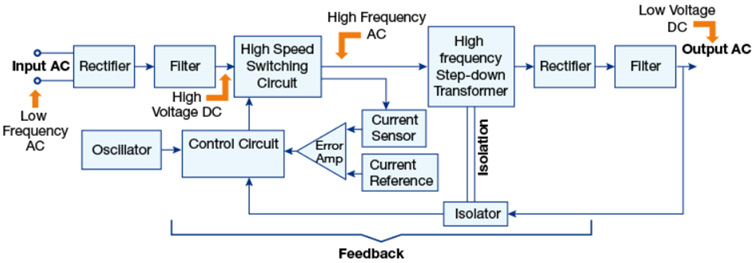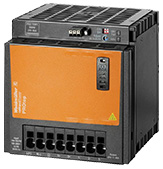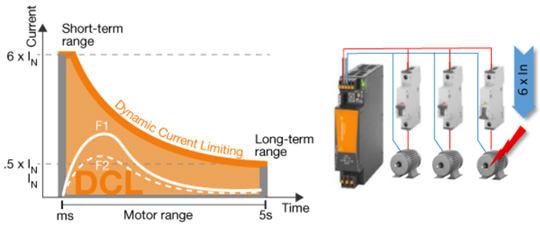Industrial Power Supplies using DCL Technology
A power supply refers to an electrical device that provides power to an electrical load in diverse conditions for multiple appliances and engineering-linked fields. Anything that supplies electrical power to any circuit is termed as a power supply since it feeds power to the circuit.
Power supplies can be classified into three common types: linearly regulated power supplies, switching power supplies, and unregulated power supplies. There is yet another kind of power supply: ripple-regulated power supply. Input sources like DC power supplies and AC power supplies are common across all power supplies. The power supply can pump out different voltages and you can choose the input type. A standard power supply comprises a transformer, voltage regulator ICs, rectifier diodes, filters, and other components. Figure 1 depicts a single-phase AC-DC switch-mode power supply (SMPS) block diagram.
Industrial level power supplies (AC-to-DC, AC-to-AC, DC-to-AC, or DC-DC) feed industries, including wind energy conversions, uninterruptible power supply (UPS) systems, and electric motor drives, among others. These are massively more powerful compared to laboratory-level power supplies, which may offer 30 Volts maximum. In contrast, industrial-level power supplies deliver a more substantial power rating of 100 Watts and even more. Efficiency is key in advanced production processes, along with high performance. Please click here to learn more about the industrial power supply.
Over-voltage, high inrush current, over-current, thermal protection, and under-voltage lockout are essential in such applications for these power supplies. A dynamic current limiting (DCL) control technique is used to shield power supplies from particular over-current faults. This article focuses on DCL integrated industrial power supply, its benefits, and a few applications.

Figure 1: Single-Phase AC-DC SMPS Block Diagram
DCL Technology and its Benefits
The DCL concept is drawn from a dynamic current limit circuit that precisely defines its upper and lower limits. The circuit ensures convenient control of both the upper and lower current limits. The normal pulse-frequency modulation (PFM) limit matches the lower current limit, and the pulse-width modulation (PWM) limit matches the upper current limit. Such implementation brings multiple benefits, like making a faultless peak current limit in dynamic and sync sleep modes. The dynamic sleep current limit of a carefully designed scheme offers an excellent load transient response.
High-end power supplies should perform reliably and efficiently, even in demanding industrial environments. Such performance needs adequate power reserves, extreme temperatures, optimal shielding against power voltage transients, vibration, and long service life. DCL technology integrated industrial power supplies, with their hardy network input level, are immune to mechanical influences. A reliable operation is thus guaranteed even in hostile conditions such as in wind power installations. The DCL technology assures high pulse reserves 24/7. The ensuing dynamic range can be employed to trigger the circuit breakers or initiating the start-up of powerful motors. For example, about 300 percent power reserve is available during a motor's starting torque for approximately 100ms and 150 percent for about 5 seconds. Even 600 percent can be used for 15ms for dependable tripping of the line circuit breakers.
This technology enhances high inrush applications performance like tripping the downstream circuit breakers and enables the power supply to manage a high inrush current for a short time or a medium-range inrush current for an extended period. It can configure shut-off parameters or continuous short circuits. The 2466920000 from Weidmuller's PROtop series is a good example of a high-end efficient and reliable power supply, able to perform even in demanding industrial environments. The product has high power reserves and an extended service life. It offers optimal protection against extreme temperature conditions, overvoltage, and vibration. For more information regarding the range of industrial power supply featured with DCL, please click here

Figure 2: 2466920000 PRO TOP1 Series AC/DC DIN Rail Power Supply 1 Output, 960 W, 48 V, 20 A
Application
We will now discuss a few applications where the role of a power supply with DCL can be easily understood.
DC Motor Starting
Production machinery must be reliable during challenging situations. A good example is when the DC motor is switched on for a standard industrial drive process event. A typical DC motor operation is characterized by high starting or inrush currents, determined by the application, which frequently exceeds the rated full load. Most DC power supplies are unable to offer this extra power to manage inrush currents. The standard solution to such a problem involved using an oversized power supply to support such inrush currents, which offers reliable protection to circumvent a voltage drop (when the motor starts) to all the other power supply connected loads. Using an oversized power supply, however, carries some drawbacks. Other than the extra cost, an oversized supply enlarges the footprint – a probable issue for compact control panel cabinets.

Figure 3: The PROtop's dynamic current limit magnetically trips a downstream circuit breaker (gray column in the preceding graph), supplies the DC motors with inrush current (white line in the preceding graph), and keeps the voltage to the other loads.
An alternate solution to this complication is to use a DC power supply similar to the DCL technology incorporated PROtop, which ensures a persistent output voltage even if the load needs six times the rated current (for a short time), or 130 percent of the rated current (continuously), or any value within these limits. Machine reliability is guaranteed via the high pulse reserves required to start the motor. The PROtop power supply, in the case of inrush currents, possesses high energy reserves, limited in power conveyed to the load (square of electrical current x time), but not limited in time. This means different loads or motors with dissimilar curves will request their respective inrush current and the power supply will dynamically adjust to cover each demand.
Circuit Protection during Short Circuit Fault
Another issue to solve is the circuit breakers being activated in the DC lines. In the event of a short circuit anywhere within the DC supply network, the protection circuits will disconnect all power supply to the faulty line, thus saving the device connected to the protected lines. However, for such protection circuits to function properly, some extra power is needed for a short period. Most power supplies are unable to provide such an extra power reserve. T he traditional solution was to install a bigger power supply. However, oversizing any power supply increases its electrical cabinet footprint and adds to the total cost. In contrast, the DCL technology of a PROtop industrial power supply retains a constant output voltage even if that load needs six times the rated current (for a brief period ), 130 percent of the continuous rated current, or any other value within these limits.
During a short circuit, the DCL technology can support the power supply operation even if that short circuit mars the automation system. The power supply limit describes the energy stored within internal capacitors and transformers. Assume that a DCL technology enables the PROtop power supply to spend all the available current if a DC branch requests a high current. This condition remains for a few milliseconds to provide sufficient time and energy to protect the damaged line's operational responsibilities. The power supply will return to rated current if the line is unprotected or shut down as per the user's choice.






